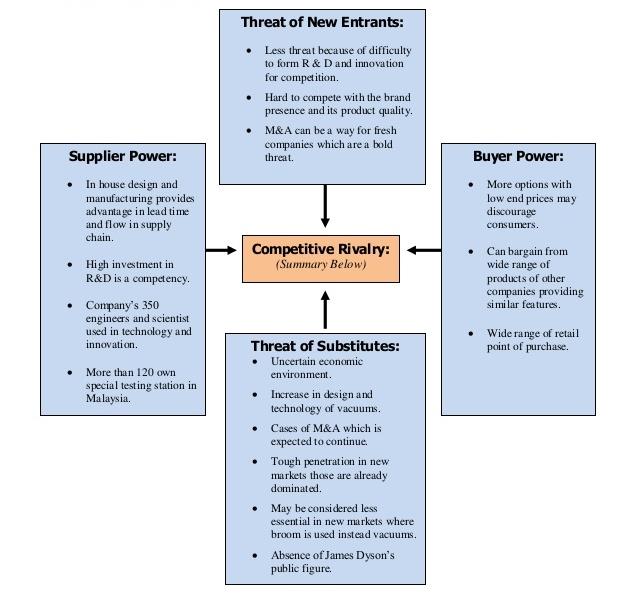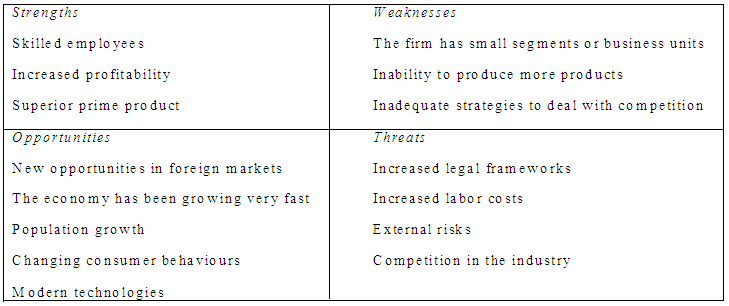Dyson is one of the leading players in the handheld vacuum industry (Dyson Company, 2016). The British corporation manufactures and markets a wide range of products such as heaters, hand dryers, and vacuum cleaners. The corporation’s success is attributed to its powerful business model. The firm embraces the concept of innovation in an attempt to come up with superior products. Dyson uses the lean production model to minimise wastes and improve the quality of its products. However, the changes experienced in the industry force Dyson to implement new strategies in an attempt to realise its business potentials (Dyson Company, 2016). This discussion gives a detailed analysis of the company’s business strategies, competitors, and existing challenges.
Analysis of Dyson’s Competitors
Dyson currently operates in an extremely competitive business environment (Prasad, 2015). The presence of competition forces the firm to implement new strategies in order to remain competitive. The level of competition in the industry can be understood using the Porter’s 5 Forces model presented below.
Porter’s 5 Forces
New Entrants
The industry is characterised by high startup costs. The current legal frameworks and use of advanced technologies discourages new players from joining the industry.
Threat of Substitutes
The firm does not encounter increased threats from substitute products. The major substitutes in the market include traditional products such as brooms, dustpans, and mops. The production of vacuum cleaners by different competitors threatens Dyson’s business performance (Motohashi, 2015).
Suppliers’ Power
These stakeholders have little bargaining power. This is the case because the suppliers have to focus on the needs of the companies.
Buyers’ Power
Since there are several competitors in the industry, the targeted customers can select the best products that can satisfy their needs. This power forces Dyson to use competitive prices and improve the quality of its vacuum cleaners.
Competition
Figure 1 below indicates that the industry is extremely competitive because it has a number of giant firms. Such firms embrace diverse strategies in an attempt to attract more customers and realise the targeted business goals.
Dyson is currently facing increased competition from firms such as Hoover, Miele, Vax Ltd, and Electrolux AB (Motohashi, 2015). Hoover is a leading competitor owned by a giant corporation known as Candy Group. This firm has “a market share of 8 percent in the United Kingdom” (Dyson Company, 2016, para. 2). Miele has been on the frontline to support the diverse needs of its customers.
The above firms embrace the best strategies to produce superior appliances. The major challenge is that “Dyson has a single prime product” (Dyson Company, 2016, para. 3). This fact explains why competition from these giant firms is a major challenge for Dyson. International companies operating in the UK market continue to dominate the industry. Consequently, Dyson has been forced to embrace new strategies and initiatives that can make it successful.
This discussion shows that competition remains a reality for Dyson. The existence of traditional cleaning equipment in the market is a major threat to Dyson’s business model. The competitors in the industry force the company to implement powerful marketing strategies (Sidhu, 2010). The concept of research and development (R&D) is taken seriously in an attempt to produce superior products that can support the needs of more customers.

Competition is extremely high in different foreign markets. For instance, the Chinese market is characterised by a wide range of local products. Such products are purchased as substitutes by many customers. This fact explains why new strategies should be implemented in an attempt to increase the company’s profitability (Prasad, 2015). The best approach towards achieving its business potential is through the use of advanced models.
Analysis of Dyson’s Strategies
Dyson implements a wide range of business strategies in an attempt to remain competitive. As a leading competitor in the industry, Dyson focuses on a number of issues such as competition and the changing needs of the targeted consumers (Sidhu, 2010). Both the internal and external environments are considered in order to produce sustainable business strategies that can deliver positive results. The firm’s SWOT Analysis is presented below.
SWOT Analysis

PESTEL Analysis
Political
The political developments experienced in Europe might affect the company’s performance. The European Union (UN) regulates the performance of different firms. Britain’s recent exit from the EU might affect the company’s performance.
Economic
The current economic growth experienced in various regions is a positive development for Dyson. New markets continue to emerge in different countries. However, recessions have continued to affect Dyson’s profitability (Blundel & Lockett, 2011).
Social
Consumer incomes have improved within the past two decades. More people continue to join the middle class. Educational programmes equip more people with new competencies (Thompson & Martin, 2011).
Technology
Modern technologies have the potential to improve the quality of Dyson’s vacuum cleaners. Many experts believe that robots might replace these vacuum cleaners.
Environment
Dyson must be aware of the environmental regulations implemented in different regions. Concepts of corporate social responsibility (CSR) have become common.
Legal
Different nations are characterised by various laws. Intellectual properties should be taken seriously by manufacturers.
The Figure 2 above indicates that Dyson encounters a wide range of issues whenever focusing on its business potentials. However, the use of powerful strategies has made Dyson a successful player in the industry. The first outstanding strategy embraced by the firm is corporate venturing. This approach focuses on collaboration with different partners in an attempt to address the needs of the more clients. Innovation is also taken seriously at the corporation (Thompson & Martin, 2011). The firm monitors the level of disruption in the industry and acquires new technologies in an attempt to achieve its business goals. The firm uses R&D to produce superior products.
In terms of marketing, various strategies are considered in an attempt to deliver positive results. To begin with, positioning strategies are used by Dyson to target specific customers in different regions. Intangible aspects such as brand reputation and image are considered to support this strategy. The firm goes further to use competitive prices whenever marketing its products (Blundel & Lockett, 2011). Premium pricing is used in an attempt to add value to its products and make them acceptable to more customers.
Product differentiation is taken seriously to meet the needs of different customers. The firm goes further to include new features that can support the needs of more clients. The firm considers new features and designs to improve its products (Glowik & Bruhs, 2014). The marketing strategy is used to target a number of regions such as Japan, Korea, and China. The firm currently sells its products to more customers across the globe. The firm customises most of its vacuum cleaners in an attempt to address the needs of its customers.
The company’s business model is therefore used to deliver positive results and profits. The model is supported by a powerful mission statement. The organisational culture embraces a number of aspects such as creativity, commitment, and teamwork. The company hires more employees from different backgrounds to improve performance. Skilled employees such as engineers and designers are attracted to support the firm’s R&D strategy. Corporate social responsibility (CSR) is embraced in order to support the needs of more communities (Thompson & Martin, 2011). The CSR approach is treated as an integral aspect of Dyson’s business model.
Analysis of the Challenges Faced by Dyson
It is agreeable that Dyson is a successful competitor in the vacuum industry. Dyson’s powerful strategies are used to attract new customers, produce innovative products, and address the changing demands of its customers. However, some challenges have continued to affect the firm’s performance in the industry (Blundel & Lockett, 2011). These challenges include lack of skilled individuals who can support the R&D strategy.
The current technological change experienced in the world is a major challenge that affects the company’s competitiveness. Modern technologies are expensive to install. Additionally, such technologies change frequently (Dyson Vacuum Cleaner, 2016). Companies that want to remain competitive must always embrace the use of such new technologies. This strategy strains the firm’s financial and human capital resources.
Competition remains a major challenge for Dyson. The above frameworks show conclusively that the industry has attracted both local and international competitors. Some of these competitors include Techtronic Industries, Hoover, Miele, and Vax Limited (Mulhearn & Vane, 2012). The companies deliver superior products that threaten Dyson’s performance. The industry is also characterised by a number of traditional cleaning products.
The changing global environment and political developments in different parts of the globe will dictate the firm’s future performance. Britain’s exit from the European Union (EU) might affect the firm’s business model. This decision will force the firm to reexamine its business strategy in Europe (Hundreds of incremental changes, 2015). Lawsuits have affected the firm over the past two decades. Such legal issues make it hard for Dyson to focus on the diverse needs of its customers.
The corporation’s internal structure is supported by small business units. Although such units have always supported Dyson’s business model, the outstanding fact is that they are less sustainable. Human capital is also a major issue affecting the firm’s business performance. Changing consumer behaviours and emergence of substitute products in different markets is a major threat to Dyson’s business model (Mulhearn & Vane, 2012). These challenges explain why new recommendations should be proposed to ensure Dyson is on the right path towards realising its business potentials.
Concluding Remarks
Dyson uses powerful strategies in an attempt to deliver admirable products to its customers. The final products produced and marketed by Dyson are capable of satisfying the needs of the customers. This fact explains why Dyson’s “brand reputation remains synchronous with innovative design and premium quality” (Prasad, 2015, p. 156). However, some challenges such as competition, changing consumer needs, and emerging technologies continue to affect the firm’s performance. A new strategy capable of tackling these challenges will eventually make Dyson a profitable company in the industry.
References
Blundel, R., & Lockett, N. (2011). Exploring entrepreneurship. New York, NY: Oxford UP.
Dyson Company. (2016). Web.
Dyson Vacuum Cleaner: Shifting from domestic to international marketing with the famous bag-less vacuum cleaner. (2016). Web.
Glowik, M., & Bruhs, S. (2014). Business-to-business: A global network perspective. New York, NY: Routledge.
Hundreds of incremental changes: A case study on Dyson. (2015). Web.
Motohashi, K. (2015). Global business strategy: Multinational corporations venturing into emerging markets. New York, NY: Springer.
Mulhearn, C., & Vane, H. (2012). Economics for business. New York, NY: Palgrave McMillan.
Prasad, K. (2015). Strategic management: Text and cases. New York, NY: PHI Learning.
Sidhu, I. (2010). Profiles in doing both: How Dyson blew away the vacuum market. The Huffington Post. Web.
Thompson, J., & Martin, F. (2011). Strategic management: Awareness and change. Upper-Saddle River, NJ: Cengage Learning.
